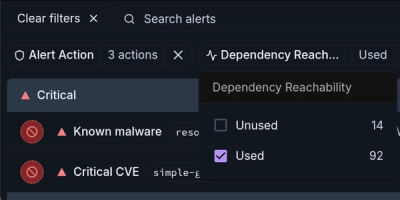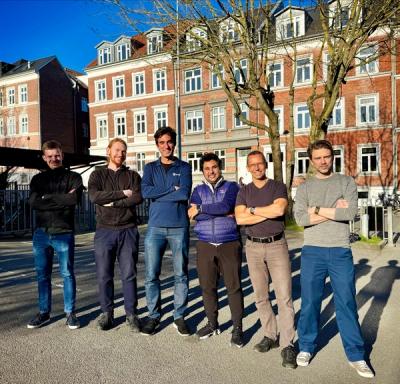
Product
Introducing Module Reachability: Focus on the Vulnerabilities That Matter
Module Reachability filters out unreachable CVEs so you can focus on vulnerabilities that actually matter to your application.
jest-puppeteer-docker
Advanced tools
Jest plugin that allows you to run your Jest tests against a Chrome instance running in Docker.
Jest preset plugin that allows you to run your tests against a Chromium instance running in Docker
Requirements:
Optional:
This plugin uses jest-puppeteer, an awesome plugin created by the developers at Smooth Code, for using Puppeteer in your tests. If you are not doing Visual Regression Testing, you may want to use that plugin directly instead.
npm install --save-dev jest-puppeteer-docker puppeteer jest
Note: You should set an environment variable PUPPETEER_SKIP_CHROMIUM_DOWNLOAD to true to avoid unnecessarily downloading a local copy of Chromium, since we will be using a container.
jest.config.js
module.exports = {
preset: 'jest-puppeteer-docker'
};
Use Puppeteer in your tests:
describe('Google', () => {
beforeAll(async () => {
await page.goto('https://google.com');
});
it('should display "google" text on page', async () => {
await expect(page).toMatch('google');
});
});
By default, Jest Puppeteer is configured by this library to connect to Chromium in the Docker container instead of launching it on the host machine. You may wish to add additional configuration, as per the puppeteer.connect options. You can add a jest-puppeteer.config.js in your package root, or reference a custom location by setting process.env.JEST_PUPPETEER_CONFIG.
Additionally, you can pass in Chromium flags to modify your launch criteria by providing a chromiumFlags array as well as other Docker Chromium arguments.
jest-puppeteer.config.js
const getConfig = require('jest-puppeteer-docker/lib/config');
const baseConfig = getConfig();
const customConfig = Object.assign({}, baseConfig);
customConfig.connect.defaultViewport = {
width: 500,
height: 500
};
customConfig.chromiumFlags = ['–ignore-certificate-errors'];
module.exports = customConfig;
jest-puppeteer-docker will pull down a Docker image with Chromium installed with the version matching the one associated with the Puppeteer dependency in your project.
When you run your tests, the container is started and jest-puppeteer-docker will connect to the Chromium instance within the container via the Chrome Debugging Protocol. Your browser navigation and interactions will be performed in the container, while the test themselves are executed in your host environment.
Once the tests finish running, the Docker container will automatically be shutdown.
If you are running a web server on your host environment, you should be able to access it from the browser in the container at host.docker.internal.
For example, if you have a server running at http://localhost:3000, you can do the following in your test:
await page.goto('http://host.docker.internal:3000/my-page');
If for any reason this doesn't work for you, check the Troubleshooting section, or create an issue.
📃 Blog post: Visual Regression Testing
The main benefit of using Docker here is to support Visual Regression Testing. Without Docker, different environments may yield unexpected results with image comparisons, due to anti-aliasing techniques. By providing a containerized environment, we can guarantee that the images produced are always the same.
jest-image-snapshot is a plugin that you can install, which will compare a screenshot with a baseline image that was previously generated when the test executed for the first time.
it('should position the title and body correctly', async () => {
const element = await global.page.$('.my-element');
const image = await element.screenshot();
expect(image).toMatchImageSnapshot();
});
Before tests execute, we can configure jest-image-snapshot globally with a threshold value, among other options, using the setupFilesAfterEnv hook provided by Jest.
jest.config.js
module.exports = {
preset: 'jest-puppeteer-docker',
setupFilesAfterEnv: ['./test-environment-setup.js']
};
test-environment.setup.js
const { configureToMatchImageSnapshot } = require('jest-image-snapshot');
const toMatchImageSnapshot = configureToMatchImageSnapshot({
failureThreshold: '0.01',
failureThresholdType: 'percent'
});
expect.extend({ toMatchImageSnapshot });

As per standard Jest configuration, we can provide a globalSetup and globalTeardown hook for doing tasks that need to happen before the test suite initializes (e.g. starting a server), and after it finishes (e.g. closing a server).
module.exports = {
preset: 'jest-puppeteer-docker',
globalSetup: './setup.js',
globalTeardown: './teardown.js',
setupFilesAfterEnv: ['./test-environment-setup.js']
};
setup.js
const { setup: setupPuppeteer } = require('jest-puppeteer-docker');
module.exports = async jestConfig => {
// any stuff you need to do can go here
await setupPuppeteer(jestConfig);
};
teardown.js
const { teardown: teardownPuppeteer } = require('jest-puppeteer-docker');
module.exports = async jestConfig => {
await teardownPuppeteer(jestConfig);
// any stuff you need to do can go here
};
Check out the example in this repository for an end-to-end example with reporting.
When configuring CircleCI, we need to enable the remote Docker engine to be able to run Docker Compose commands for building the Chrome container. This is achieved by adding the setup_remote_docker build step.
However, the job that runs in the base container is on a separate environment from the remote Docker engine (for security reasons). This means the remote container cannot access network resources from the base container, and is a problem for us. You can read more about Running Docker commands.
In order to get around this, we can use machine executor instead of the Docker one. This comes with Docker Compose installed, allowing us to interact with the container over the same network.
Checkout the example CircleCI config. It's worth noting that we need to set the NVM environment variable for every task because it gets reset, which is rather annoying.
If you have a better solution than this, please let me know as I don't know CircleCI very well.
FAQs
Jest plugin that allows you to run your Jest tests against a Chrome instance running in Docker.
The npm package jest-puppeteer-docker receives a total of 665 weekly downloads. As such, jest-puppeteer-docker popularity was classified as not popular.
We found that jest-puppeteer-docker demonstrated a not healthy version release cadence and project activity because the last version was released a year ago. It has 1 open source maintainer collaborating on the project.
Did you know?

Socket for GitHub automatically highlights issues in each pull request and monitors the health of all your open source dependencies. Discover the contents of your packages and block harmful activity before you install or update your dependencies.

Product
Module Reachability filters out unreachable CVEs so you can focus on vulnerabilities that actually matter to your application.

Company News
Socket is bringing best-in-class reachability analysis into the platform — cutting false positives, accelerating triage, and cementing our place as the leader in software supply chain security.

Product
Socket is introducing a new way to organize repositories and apply repository-specific security policies.